Stalin learning from his mistakes? Pish-posh! The only thing wrong with the glorious people's airborne attack was that not enough paras were dropped! The entire people's army must be trained in the ways of airborne assault!
The War that Had to Be Won (1936: The Road to War)
- Thread starter Kurt_Steiner
- Start date
-
We have updated our Community Code of Conduct. Please read through the new rules for the forum that are an integral part of Paradox Interactive’s User Agreement.
You are using an out of date browser. It may not display this or other websites correctly.
You should upgrade or use an alternative browser.
You should upgrade or use an alternative browser.
Oh no, that would be just what the scheming, plotting, couping officer corps wants! It was their fault! More Purges!
Oh no, that would be just what the scheming, plotting, couping officer corps wants! It was their fault! More Purges!
The Soviet Paras just dropped in to see what condition their Finn was in...
In any event, the officer corps must be purged once again! To the Purgemobile Laventeri!
Wow, just how insane is the Soviet AI? It seems it wants to help you keep up your grand work!
The Soviet Paras just dropped in to see what condition their Finn was in...
In any event, the officer corps must be purged once again! To the Purgemobile Laventeri!
Blahh! The Soviets need no stinking officer corps! Men fight just as lousy without them!
Chapter thirty-five: Plan Green.
The first cabinet meeting of Winston Churchill began with dire news. The guns were roaring fron a wide frontline going from the Barents to the Adriatic Sea. With France joining the war and the Soviet raid against Zagreb and Ljubljana and the war declaration that followed, the madness of war seemed to engulf the whole continent.
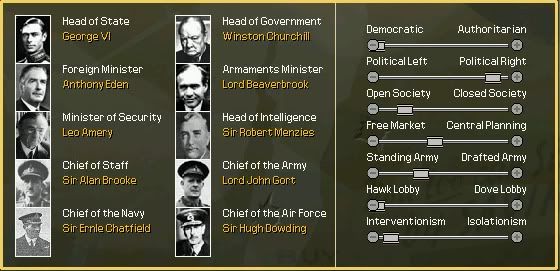
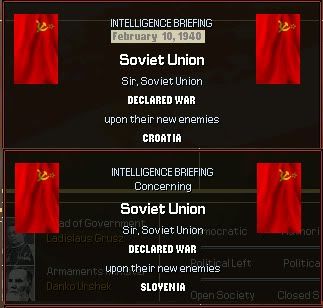
As in 1914, the British Expeditionary Force departed to the continent at once. The first forces to depart were the units from the III Corps, under General John Dill, KCB, CMG, DSO. It would take ten days for the Corps to arrive to Sttetin, in the Baltic, though. Meawnhile, the RAF was flying to the continent. The No 2 Air Command (a mixture of Wellingtons and outdated Hampdens), and the Strategic Bomber Command (with the heavy Whitley), flew to Germany, from where they would strike deep in the heart of the enemy forces.
The Empire was on the move. The New Zealand Expeditionary Force would take even longer to arrive to the Continent, as it hardly departed to Australia, from where it would be embarked, along with the Australian Imperial Force, in a massive convoy bound to Europe. In Canada the first forces of an Army Corps were being gathered to send to Britain, with a second Corps was on the making.

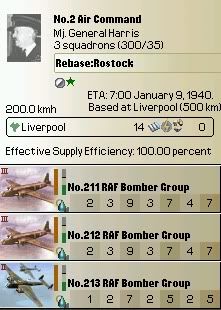

However, the German Generals were not up to wait for reinforcements. Even if their forces were spread all over Pommerania, Saxony and Brandenburg and their Panzer divisions (I, II, III and VIII Panzerkorps) still moving to the front, the Großer Generalstab was eager to recover the Polish corridor and determined to strike the first blow before the enemy was ready to attack. Thus the 2. and 3. Armee (26 Infantry Divisions) plus the IV (Kempf, with the 4. and 7. Panzer Divisions) and VI Panzerkorps (Hausser, with the 8. and 11. Panzer Divisions), supported by the 4. Armee in Prussia (von Schobert, 9 Infantry Divisions) rushed forward, World War One style, against the combined Polish and Soviet Forces (the Pomorze, Poznan, Kutno and Krakow armies plus the Soviet 2th, 65th and 70th Armies), which were still deploying when the German onslaught came over them.
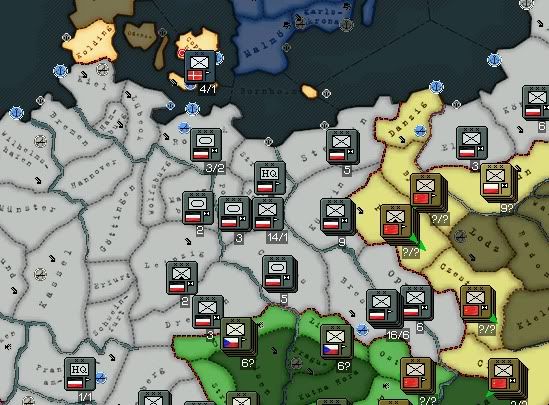
The Deutsche Luftstreitkräfte, of course, was not iddle: eleven Kampfgeschwader and Zerstörergeschwader covered the skies with a massive armada of Junkers Ju 88s, Heinkel He 111s and Messerchsmitt Me 110s.
However, the first shots in Eastern Europe were not going to be fired in Poland. The intelligence service of the South Army Group under General von Reichenau had noticed the arrival of two Soviet Army corps (apparently from the 1st Guards Army and some other unidentified Soviet force) to the frontlines in Slovakia. Thus, von Reichenau cabled Berlin of his intentions and then applied the so-called "Fall Grün", a pre-war German plan for an aggressive war against Czechoslovakia: 350,000 German soldiers would storm the impregnable border fortifications and then rush to Prague under the cover of the Deutsche Luftstreitkräfte.
Would that daring bet work?
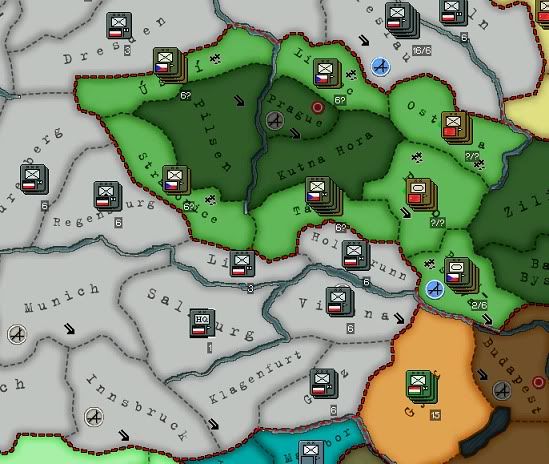
@Mr. Santiago: Then this AAR would be quite short...
@trekaddict: 1) Getting into the Soviet side and making it to be build. That the Soviet IA used it was a whole surprise to me.
2) Not if you're Zukov and have to tell Comrade Stalin that the battle is not going exactly as planned.
3) Historically the FAF was thus equipped. Let's hope that Britain may offer them a deal that they can't refuse...
4) Will there still be the Royals in Buckingham Palace? I just hope that the Armor boys give a chance to use them.
@H.Appleby: Uncle Joe's way to learn is by using some firing squads and to start from scratch. Methinks that the shtrafbats are going to be created sooner than expected...
@trekaddict -2-: Purges? Why purging someone if you can use them as cannon fooder! Let's force the waste of ammo to the Capitalist filth!
@H.Appleby -2-: Well, they going to have the chance to improve their Finn skills ni the POW camps.
Again. Be logical, my good comrade! By purging! Use them in the shtrafbats! Why wasting a bullet in a traitor when he can be used to find a mine?
@Sumeragi: Yes, it looks that way.
@Nathan Madien: Men, I would love to see the whole Ukranian Army Front making a big soviet to decide in which direction to advance


@krafen73: Thank you and welcome!
The first cabinet meeting of Winston Churchill began with dire news. The guns were roaring fron a wide frontline going from the Barents to the Adriatic Sea. With France joining the war and the Soviet raid against Zagreb and Ljubljana and the war declaration that followed, the madness of war seemed to engulf the whole continent.


The Empire was on the move. The New Zealand Expeditionary Force would take even longer to arrive to the Continent, as it hardly departed to Australia, from where it would be embarked, along with the Australian Imperial Force, in a massive convoy bound to Europe. In Canada the first forces of an Army Corps were being gathered to send to Britain, with a second Corps was on the making.



However, the German Generals were not up to wait for reinforcements. Even if their forces were spread all over Pommerania, Saxony and Brandenburg and their Panzer divisions (I, II, III and VIII Panzerkorps) still moving to the front, the Großer Generalstab was eager to recover the Polish corridor and determined to strike the first blow before the enemy was ready to attack. Thus the 2. and 3. Armee (26 Infantry Divisions) plus the IV (Kempf, with the 4. and 7. Panzer Divisions) and VI Panzerkorps (Hausser, with the 8. and 11. Panzer Divisions), supported by the 4. Armee in Prussia (von Schobert, 9 Infantry Divisions) rushed forward, World War One style, against the combined Polish and Soviet Forces (the Pomorze, Poznan, Kutno and Krakow armies plus the Soviet 2th, 65th and 70th Armies), which were still deploying when the German onslaught came over them.

The Deutsche Luftstreitkräfte, of course, was not iddle: eleven Kampfgeschwader and Zerstörergeschwader covered the skies with a massive armada of Junkers Ju 88s, Heinkel He 111s and Messerchsmitt Me 110s.
However, the first shots in Eastern Europe were not going to be fired in Poland. The intelligence service of the South Army Group under General von Reichenau had noticed the arrival of two Soviet Army corps (apparently from the 1st Guards Army and some other unidentified Soviet force) to the frontlines in Slovakia. Thus, von Reichenau cabled Berlin of his intentions and then applied the so-called "Fall Grün", a pre-war German plan for an aggressive war against Czechoslovakia: 350,000 German soldiers would storm the impregnable border fortifications and then rush to Prague under the cover of the Deutsche Luftstreitkräfte.
Would that daring bet work?

@Mr. Santiago: Then this AAR would be quite short...
@trekaddict: 1) Getting into the Soviet side and making it to be build. That the Soviet IA used it was a whole surprise to me.
2) Not if you're Zukov and have to tell Comrade Stalin that the battle is not going exactly as planned.
3) Historically the FAF was thus equipped. Let's hope that Britain may offer them a deal that they can't refuse...
4) Will there still be the Royals in Buckingham Palace? I just hope that the Armor boys give a chance to use them.
@H.Appleby: Uncle Joe's way to learn is by using some firing squads and to start from scratch. Methinks that the shtrafbats are going to be created sooner than expected...
@trekaddict -2-: Purges? Why purging someone if you can use them as cannon fooder! Let's force the waste of ammo to the Capitalist filth!
@H.Appleby -2-: Well, they going to have the chance to improve their Finn skills ni the POW camps.
Again. Be logical, my good comrade! By purging! Use them in the shtrafbats! Why wasting a bullet in a traitor when he can be used to find a mine?
@Sumeragi: Yes, it looks that way.
@Nathan Madien: Men, I would love to see the whole Ukranian Army Front making a big soviet to decide in which direction to advance
@krafen73: Thank you and welcome!
Last edited:
The Führer's dreams being realized in this reality? What is this madness!
You know, the Soviets are making this too easy for Germany.
You know, the Soviets are making this too easy for Germany.
My money is on Germany crushing the Czechs...
...no offense, but the Czech's cances of victory are 250 to one.
...no offense, but the Czech's cances of victory are 250 to one.
Good luck fighting in the mountains, fellas.
You seem to forget who the Germans are Allied with. Gurkhas. The Ultimate Mountain Troops! (tm)
You seem to forget who the Germans are Allied with. Gurkhas. The Ultimate Mountain Troops! (tm)
For me, it should be:
"You need to know who the Germans are Allied with."
I don't know who the Gurkhas are.
I think it might be a good idea for the German forces in East Prussia to seize Danzig and then use it as a corridor to retreat into the main body of Germany. East Prussia looks very vulnerable from where I am standing and the loss of at least nine divisions to the Soviets... wouldn't be pleasant for Allied fortunes in the war. Alternatively, you could evacuate them by sea.
talt
talt
Chapter thirty-six: Thor's Hammer.
Von Reichenau's plan was extremely simple: his Army Group was to pierce the enemy lines in two points at the same time in order to go through the complex system of border fortifications and race towards Prague. The defensive system had been built from 1935 to 1938 and that the Communist regime was reinforcing since late 1939. Although it was incomplete, it was still a formidable obstacle reinforced by the natural defences. However, as the first Germans shells landed on the pillboxes, hell was unleashed among the Czech army.
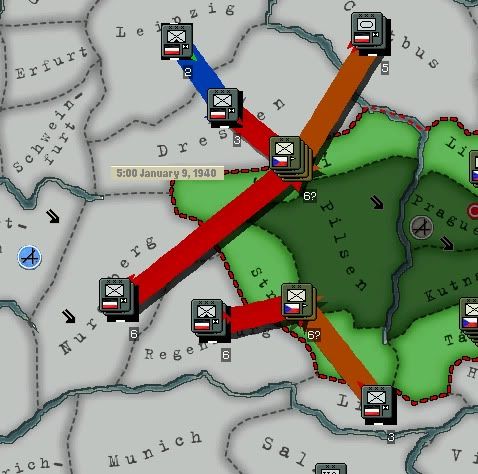
In an example of foresight, the OKH had assigned to von Reichenau's Army Group the heaviest guns of the German arsenal: the Artillerie-Batterie 717 and 718 (E) equipped with three 17 cm Kanone in Eisenbahnlafette (17 cm K (E)) each; the Artillerie-Abteilungen 767 and 768, the only Heer battalions to field 21 cm heavy guns (4 guns) during the war; two batteries of the I./AR 84 which fielded four 24 cm Kanone 3; the Batteries 664, 721, 722 (five 24 cm Theodor Bruno Kanone (E) railroad guns all in all), 674 (E) (two 24 cm Theodor Kanone (E)) and 689 (two 28 cm schwere Bruno Kanone (E)), and the schwere Batterie 833 (six 60 cm "Karl-Gerät" (040/041) self-propelled siege mortars).
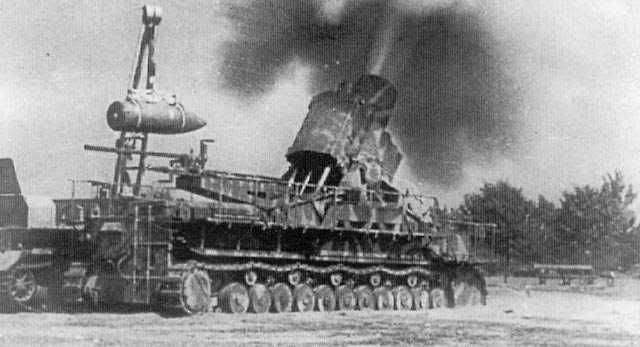
60 cm Karl-Gerät "Ziu" firing against Czech fortifications.
With this firepower available, the Armée Gruppe B hoped to smash the Czech fortifications in single stroke. Thus, at 5.00 am, January 9, 1940, the massive concentration of fire of the artillery barrage opened the attack against the pillboxes in the Teplice-Deecin area, in the north of the country, and against those in the Kdyne-Nyrsko area, in the south. By January 10th they had opened the way to the German forces and used more ammunition that the one used by the British Army during the first day of the Battle of the Somme.
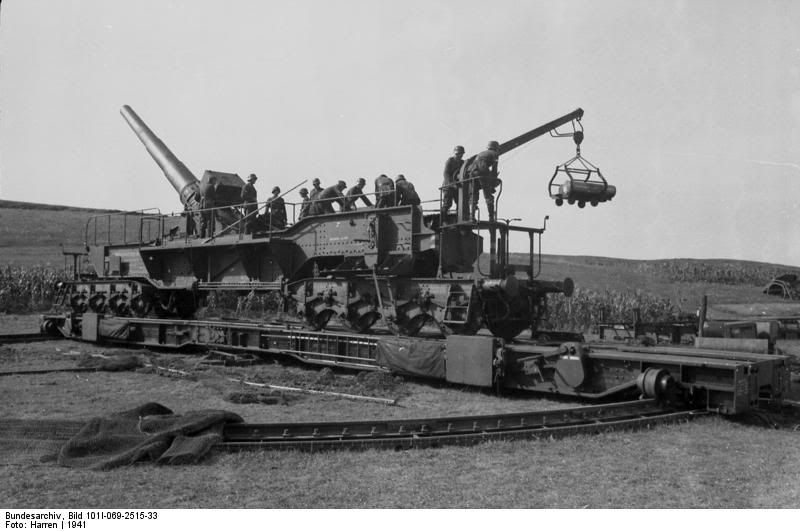
A Theodore Kanone mounted on a Vögele turntable; note the ammunition being hoisted up to the mount

@Sumeragi: No, this is Spartaaaaaaaaaaaaaaaa!!!! Oh, Peti! Darn you! I told you to dig the darned hole to kick people!
Too easy. Darn it.
@Razgriz 2K9: We shall see.
@Nathan Madien: A pity zat ze Kaiser has no Gestapo to deal wiz defeatist like you...
@trekaddict: Yeah, but it may take a bit of a time to take them from the God's forsaken corner they are in India into Europe, you know...
@Nathan Madien (2): Shame on you. I'm beginning to worry about you, Natham...
@trekaddict. (2) and with a good reason.
@talt: Ve? Retreat? Zat's unGerman! Zat's unPrussian!
Zat's a possibility...
Don't worry, the Kaiserliche Marine is ready to give a hand. The Royal Navy is too busy (Shut up server) carrying the Dominions troops to the Continent.
Last edited:
now, the real action begins!!!, the Wehrmacht is in the path of victory, keep it that way kurt, fur Kaiser, Gott und Vaterland
¿what are doing the bolsheviks? ¿massing troops on the frontier?
¿what are doing the bolsheviks? ¿massing troops on the frontier?
Quibble: It's Kaiserliche Marine (Imperial Navy) not Kriegsmarine. That one was an invention by the accursed Austrian.
Comment: Methinks the Czechs will fall eventually but not as fast as the Germans think.
Comment: Methinks the Czechs will fall eventually but not as fast as the Germans think.
Is that a Hungarian squadron I see above Danzig? Now, for Greater Germany! Onward!
...and used more ammunition that the one used by the British Army during the first day of the Battle of the Somme.
Ah, yes. Way back when. Good times.

60 cm Karl-Gerät "Ziu" firing against Czech fortifications.
Is it just me or are there no people in this picture?
Last edited:

